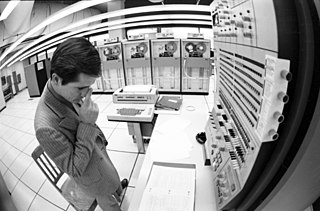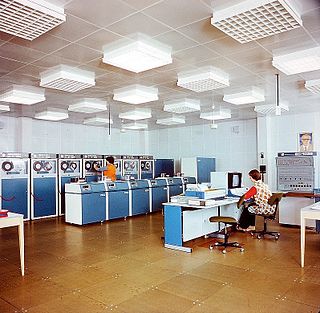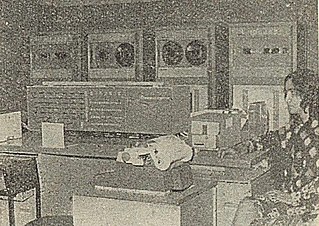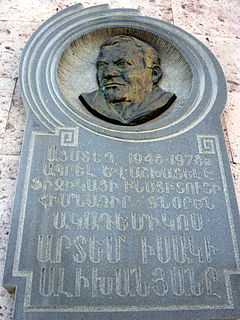
Magnetic tape is a medium for magnetic storage, made of a thin, magnetizable coating on a long, narrow strip of plastic film. It was developed in Germany in 1928, based on magnetic wire recording. Devices that record and playback audio and video using magnetic tape are tape recorders and video tape recorders respectively. A device that stores computer data on magnetic tape is known as a tape drive.

Computer operating systems (OSes) provide a set of functions needed and used by most application programs on a computer, and the links needed to control and synchronize computer hardware. On the first computers, with no operating system, every program needed the full hardware specification to run correctly and perform standard tasks, and its own drivers for peripheral devices like printers and punched paper card readers. The growing complexity of hardware and application programs eventually made operating systems a necessity for everyday use.

An audio tape recorder, also known as a tape deck, tape player or tape machine or simply a tape recorder, is a sound recording and reproduction device that records and plays back sounds usually using magnetic tape for storage. In its present-day form, it records a fluctuating signal by moving the tape across a tape head that polarizes the magnetic domains in the tape in proportion to the audio signal. Tape-recording devices include the reel-to-reel tape deck and the cassette deck, which uses a cassette for storage.

Bubble memory is a type of non-volatile computer memory that uses a thin film of a magnetic material to hold small magnetized areas, known as bubbles or domains, each storing one bit of data. The material is arranged to form a series of parallel tracks that the bubbles can move along under the action of an external magnetic field. The bubbles are read by moving them to the edge of the material, where they can be read by a conventional magnetic pickup, and then rewritten on the far edge to keep the memory cycling through the material. In operation, bubble memories are similar to delay-line memory systems.

The IBM 701 Electronic Data Processing Machine, known as the Defense Calculator while in development, was IBM’s first commercial scientific computer and its first series production mainframe computer, which was announced to the public on May 21, 1952. It was invented and developed by Jerrier Haddad and Nathaniel Rochester based on the IAS machine at Princeton.

A magnetic stripe card is a type of card capable of storing data by modifying the magnetism of tiny iron-based magnetic particles on a band of magnetic material on the card. The magnetic stripe, sometimes called swipe card or magstripe, is read by swiping past a magnetic reading head. Magnetic stripe cards are commonly used in credit cards, identity cards, and transportation tickets. They may also contain an RFID tag, a transponder device and/or a microchip mostly used for business premises access control or electronic payment.
Magnetic Scrolls was a British video game developer active between 1984 and 1990. A pioneer of audiovisually elaborate text adventure games, it was one of the two largest and most acclaimed interactive fiction developers of the 1980s.

ES EVM is a series of clones of IBM's System/360 and System/370 mainframes, built in the Comecon countries under the initiative of the Soviet Union between 1968 and 1998. More than 15,000 of ES EVM mainframes were produced in total.

Magnetic storage or magnetic recording is the storage of data on a magnetized medium. Magnetic storage uses different patterns of magnetisation in a magnetizable material to store data and is a form of non-volatile memory. The information is accessed using one or more read/write heads.

Mount Aragats is an isolated four-peaked volcano massif in Armenia. Its northern summit, at 4,090 m (13,420 ft) above sea level, is the highest point of the Lesser Caucasus and Armenia. It is also one of the highest points in the Armenian Highlands.

Sound recording and reproduction is the electrical, mechanical, electronic, or digital inscription and re-creation of sound waves, such as spoken voice, singing, instrumental music, or sound effects. The two main classes of sound recording technology are analog recording and digital recording.
The A.I. Alikhanyan National Science Laboratory is a research institute located in Yerevan, Armenia. It was founded in 1943 as a branch of the Yerevan State University by brothers Abram Alikhanov and Artem Alikhanian. It was often referred to by the acronym YerPhI. In 2011 it was renamed to its current name A.I. Alikhanyan National Science Laboratory.

The first Nairi computer was developed and launched into production in 1964, at the Yerevan Research Institute of Mathematical Machines, and were chiefly designed by Hrachya Ye. Hovsepyan. In 1965, a modified version called Nairi-M, and in 1967 versions called Nairi-S and Nairi-2, were developed. Nairi-3 and Nairi-3-1, which used integrated hybrid chips, were developed in 1970. These computers were used for a wide class of tasks in a variety of areas, including Mechanical Engineering and the Economics.

Sergey Mergelyan was a Soviet Armenian mathematician, who made major contributions to the Approximation Theory. The modern Complex Approximation Theory is based on Mergelyan's classical work. Corresponding Member Academy of Sciences of USSR, member of NAS ASSR.
Magnetic-tape data storage is a system for storing digital information on magnetic tape using digital recording.

Artyom Isaakovich Alikhanian was a Soviet and Armenian physicist, one of the founders and first director of the Yerevan Physics Institute, a correspondent member of the Academy of Sciences of the Soviet Union (1946), academic of the Armenian National Academy of Sciences. With Pyotr Kapitsa, Lev Landau, Igor Kurchatov, Abram Alikhanov and others, he laid the foundations of nuclear physics in the Soviet Union. He is known as the "father of Armenian physics".

The Yerevan Computer Research and Development Institute (YCRDI), is a scientific research institute and the pioneer of the IT and software industry in Armenia. It was founded by the government of USSR in 1956 in Yerevan for the development of computer equipment. The institution is currently involved in the development of computers and automatic control systems for civil and defense purposes. At the beginning of the 1990s, the institute employed over 7,000 staff.
The Alikhanian–Alikhanov spectrometer was a large solenoid physical instrument constructed by brothers Abraham Alikhanov and Artem Alikhanian at the Aragats scientific station in Armenia. The spectrometer was unique in the world.

Gregory Markari (Markarovich) Garibian was a Soviet Armenian physicist, academician-secretary of the Department of Physics and Mathematics of the Armenian Academy of Sciences (AS)(1973–1991). He is known for developing the Theory of Transition Radiation and showing the feasibility of functional transition radiation detectors (TRDs). [8] [9]

Ashot Chilingarian is an Armenian physicist known for his contributions to the fields of high-energy astrophysics, space weather, and high-energy atmospheric physics. He is the head of the Cosmic Ray Division (CRD) and the director of the Alikhanyan Physics Institute in Armenia.















